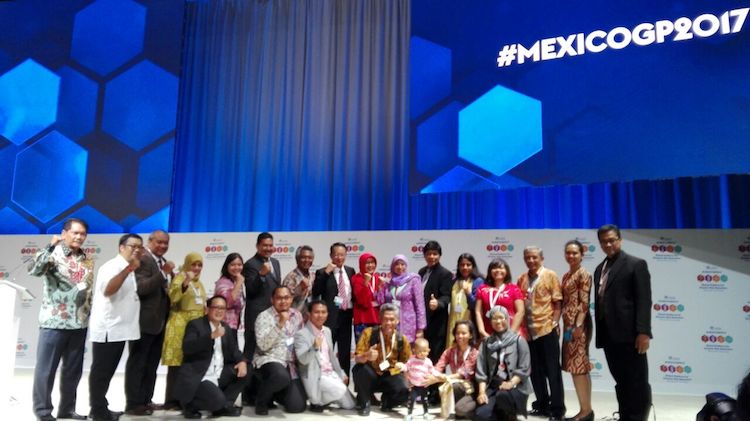This is the second of two reports from the 2017 Global Platform for Disaster Risk Reduction conference held in Cancun, Mexico, from May 22 to 26.
By Ek Soria
MEXICO CITY (IDN) – Over the last century, population growth and unplanned urbanisation, overexploitation of natural resources and the effects of climate change have dramatically increased the economic, social and cultural costs of disasters.
A disaster should be understood as a correlation between natural phenomena such as earthquakes, tsunamis and volcanic eruption or phenomena caused by industry and people, such as deforestation, environmental pollution, and economic, social and cultural and physical conditions in vulnerable communities, including poor health, poorly constructed homes, unstable soils, poor location of dwellings through ignorance or territorial displacement caused by extractive projects, apathy and indifference, and lack of organisation and popular participation.
The preservation of natural resources in underdeveloped economies has been a minor concern in development plans of recent decades. Forests, mangroves, glaciers, rivers, and forests that play a fundamental role in the balance of the planet have been systematically exploited to produce wealth and that exploitation has not been repaired through environmental, social, political and economic action to deal with the consequences.
Indicators for the measurement of impact traditionally focus on economic figures that involve calculation of losses or predictions of what reconstruction – which may or may not take place – would cost. The impact on people’s lives has taken second place, and further down the agenda the question of protecting people.
This was one of the underlying themes at the 2017 Global Platform for Disaster Risk Reduction conference, which was held in Cancun from May 22 to 26, where working groups and plenary meetings pointed out the need for a dynamic forum bringing together governments, stakeholders, the private sector and civil society to create greater responsibility for strengthening resilience to disasters.
The Global Platform was established for implementing the Sendai Framework for Disaster Risk Reduction adopted in Sendai, Japan, in 2015
One of the issues that came to the fore was that of mining activities in Latin America, which has become one of the main territories for the expansion of mining worldwide.
Participants were told of the resistance developed by various communities in defence of commons and a number of conflicts linked to large-scale mining, which has a noted impact on the environment and often violates human rights, as documented by the Observatory of Mining Conflicts in Latin America (OCMAL) and the Inter-American Court of Human Rights.
All types of mineral resources have been exploited in Latin America for centuries, with a number of governments considering it a source of income – to the extent that there has been a sort of regional consensus from the 1990s to attract foreign capital by providing most of the facilities for the expansion of mining and guarantees for the extraction of minerals.
Mining operations remain profitable in the region due to the low cost of production and transportation to ports, the increased volume of sales and the value of local currencies. Some say that these are the best conditions a developing country could have because they permit the flow of capital, but the production of wealth is not usually felt among the people who are employed in the worst conditions under the promise of desired development, much less for entire communities that are forced to move to uneven terrain.
There are more than 200 mining disputes and more than 300 communities affected by disasters because of extraction activities in Latin America. In some cases, the social fabric has broken down into the basic questions of water or mining, bread or mining, life or mining? In others, the social fabric has been strengthened through solidarity, negotiation and people’s capacity for resilience.
The debate is not new: the push for more extensive mining comes up against the defence of environmental, indigenous and community rights, and proponents of the latter look to the Sendai Framework as the principle to be applied. However, in many cases, the lengthy duration of mining conflicts is accompanied by the inability or lack of willingness of local and national governments to protect life; in many others they do not respect international treaties or commitments.
There continues to be a real risk that indicators will continue to measuring the costs of disasters in dollars rather than taking into full account the implications on the health, culture, environment, customs and ways of life of affected social groups – or using the best technologies to identify the arrival of drought or the poisoning of water, earth and air, without the powers necessary to mitigate them.
It is likely that peoples and communities will recover confidence in institutions if there is clear evidence of the willingness of States to guarantee the right to life. This means that States would have to return to work for effective regulation and protection of people – and that industry will have to adapt and respect international agreements and covenants with no tricks. It can be done. [IDN-InDepthNews – 31 May 2017]
Photo: Participants at the 2017 Global Platform for Disaster Risk Reduction conference held in Cancun, Mexico, from May 22 to 26. Credit: Ek Soria
IDN is flagship agency of the International Press Syndicate

